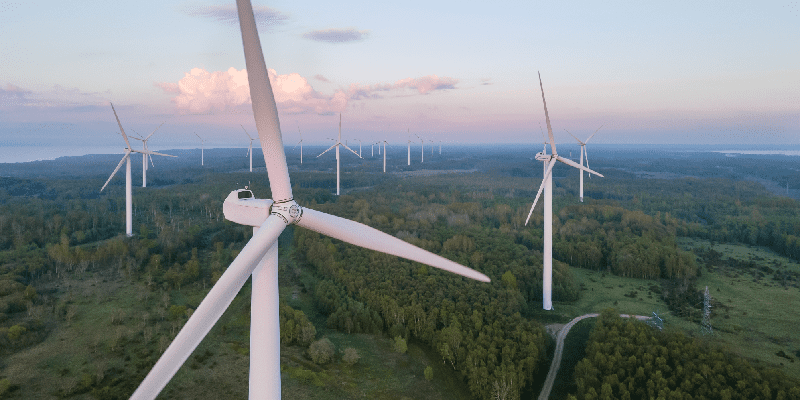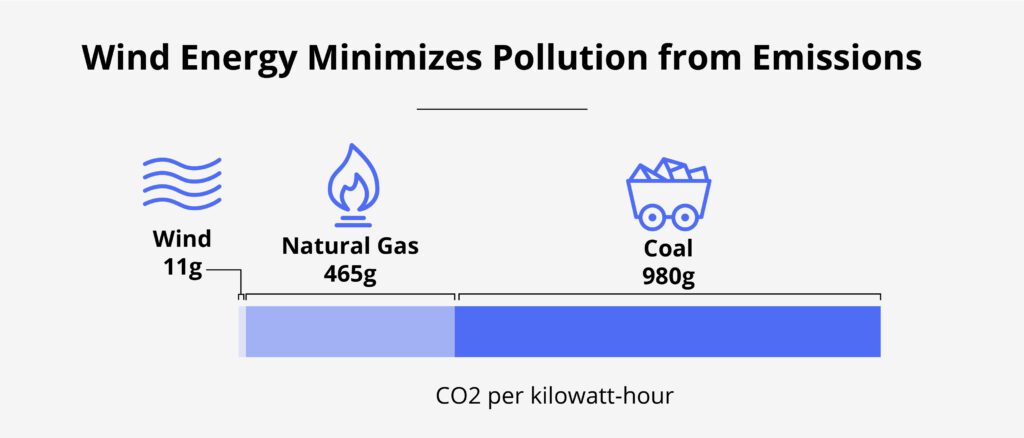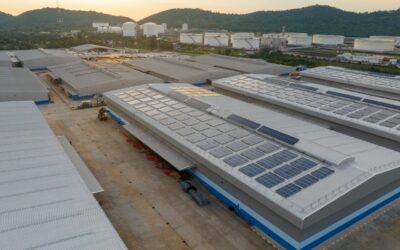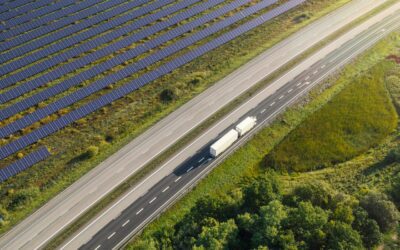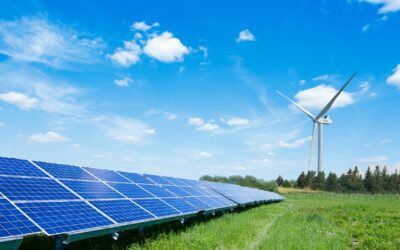7 Practical Advantages of Wind Energy
Environmental Advantages of Wind Energy
Wind turbines contribute to environmental responsibility through low greenhouse gas emissions and reliance on an infinite energy source. Plus, thanks to advancements in engineering, modern wind turbines are largely made of recyclable materials so wind energy can achieve the lowest environmental impact possible.
Wind Energy Minimizes Pollution from Emissions
Energy generation from wind is a nearly 100% emission-free process. Once wind turbines are installed, they contribute virtually nothing to water or air pollution since they do not burn fuel. Turbines generate electricity by capturing the kinetic energy of wind. As the wind turns the blades, they rotate a drive shaft that is connected to a generator. This process creates electricity without releasing emissions that harm local air quality or contribute to climate change.
The full lifecycle of a wind turbine does involve carbon emissions, but this is due to manufacturing and shipping – not the process of electricity generation itself. Total carbon emissions resulting from wind energy is 90x lower than coal and 40x lower than natural gas, making this a clean energy source with one of the lowest carbon footprints₁
Renewable Energy Conserves Natural Resources
Wind is an inexhaustible, or renewable energy source that does not rely on limited natural resources such as fossil fuels. This long-term sustainability is one of the main advantages of wind energy, contributing to environmental conservation and reducing dependence on finite resources that can be depleted. Additionally, the risk of damage to the earth through mining and drilling is mitigated with wind.
Turbines are Successful in a Variety of Environments
Wind turbines are a familiar sight when passing through American farmland, but it’s worth noting that wind energy is suitable for a diverse range of environments beyond windy plains. Onshore turbines also harness the power of wind on the high points of hilly regions and in wind tunnels created by mountain gaps.
Offshore wind energy takes advantage of high wind speeds over the ocean, bringing renewable energy to coastal regions. Ocean turbines are engineered to withstand their corrosive environment and are usually more powerful than land turbines. Installing turbines offshore gives them room to operate with fewer obstructions – allowing for larger sizes – and exposes them to more constant wind.
Modern Turbines are Recyclable
A long-standing critique of wind turbines is the damage they cause to the environment after they break down since these giant machines have historically been disposed of in landfills. Landfills are a cheap way of discarding old wind turbines, and this remains a legitimate downside to wind energy. However, the problem of wasting materials is not unique to wind energy, and modern wind turbines are actually manufactured to address this issue.
The U.S. Department of Energy (DOE) reports that 85-90% of a wind turbine’s mass is made of materials that can be recycled, with efforts underway to eventually engineer a 100% recyclable machine.₂ And with a lifespan of over 20 years, wind turbines are not discarded or recycled frequently.
Economic Advantages of Wind Energy
Wind energy is highly praised for its environmental benefits, and there are also a number of economic advantages to installing wind turbines. Wind power is a significant source of energy that comes at an affordable cost since there are no fuel expenses and minimal supervision is needed to keep the turbines operating. The wind industry as a whole contributes to economic growth both locally and nationally, by prioritizing homegrown resources and creating jobs.
Wind Energy is Powerful and Cost-Effective
The power capacity of a wind turbine depends drastically on its size – which ranges from small, residential models resembling old-fashioned windmills to massive, offshore machines taller than the Statue of Liberty. Onshore, utility-scale wind turbines installed within the last year have an average power capacity of 3.2 megawatts (MW), or 3,200,000 watts. This number is only expected to grow with technological advancements in the wind energy industry.
As turbines increase in power, their cost effectiveness will also continue to increase. Currently averaging 1.5 to 4 cents per kWh (kilowatt-hour), wind prices for power contracts rival the costs of alternative power sources₃. Even without federal subsidies, an average of 5 cents per kWh keeps wind prices competitive₄. Unlike power plants, the up-front costs of installing wind turbines are ultimately counteracted by low day-to-day operating costs. In general, turbines only need maintenance checks 2-3 times per year. These ongoing improvements in technology and operations efficiency combine to create an economical and sustainable energy source.
Land Leases Profit Local Landowners
Wind turbines and wind farms require significant space to operate, so many energy companies rely on local landowners to rent out their property – bringing revenue to local economies. Profits depend on the size of the wind turbines and the terms of the rental agreement, but landowners can make anywhere from a few thousand dollars to 5-figure deals annually.
Wind projects have long-term, 20-30-year contracts that are locked in – and unlike other energy sources – are unaffected by fuel prices. Landowners make money on these projects through a fixed annual rental rate for their property, and/or through royalties. Royalties reward the landowner a percentage of profits based on how much energy the wind turbines generate over a given period of time. This allows property owners to receive profits that correspond to rising energy prices as well as the actual performance of the turbines.
Wind Turbine Industry Supports Domestic Jobs
Wind is a homegrown energy source, reducing reliance on fuel from other countries. Global conflicts and political turmoil subject the fossil fuel industry to unpredictable changes such as shortages and price gouging. Wind energy has an advantage here as a renewable energy source with a process that relies on domestic investments.
Wind energy also stimulates the national economy by creating domestic jobs. Wind turbine components continue to be primarily imported from outside the United States; however, the wind industry is growing and already relies on a significant domestic labor force in the manufacturing, construction, and logistics sectors. The latest land-based wind market report from the DOE found that the wind energy industry in the U.S. currently employs over 125,000 people₅.
The job creation potential of wind energy is no surprise considering turbines are built from several thousand components – the most obvious of which are two to three-hundred foot turbine blades that must be transported as one piece. Transporting wind turbine blades requires not only the right trucking equipment and permits but also experienced drivers who know how to handle this unique load and its challenges.
Expect Continued Growth in the Wind Energy Sector
Contact the Heavy Haul Experts at Titan Worldwide for Wind Turbine Transportation
Consult with Titan Heavy Haul before you make plans to purchase or install wind turbines. You will need a reliable logistics partner with extensive experience in transporting heavy machinery to make sure the process goes smoothly and safely!
